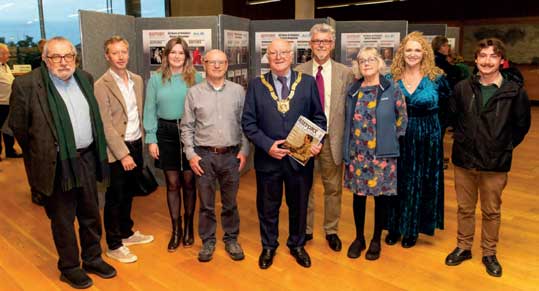By Felix M. Larkin
History Ireland has celebrated 30 years of almost continuous publication with an exhibition of its front covers in the Lexicon Library and Cultural Centre in Dún Laoghaire. The exhibition was launched by the cathaoirleach of Dún Laoghaire–Rathdown County Council, Councillor Denis O’Callaghan, on 4 October 2023.

There have been 160 issues of History Ireland—including this one—and four special supplements since the first issue in Spring 1993. One of the glories of the magazine has been its eye-catching front covers—some specially commissioned but more usually incorporating a historical painting or photograph. It is appropriate, therefore, that the exhibition in the Lexicon should have featured its covers.
Tommy Graham has been the editor since History Ireland began, though jointly with Hiram Morgan for the first ten years. The magazine was published originally four times per annum, but since 2005 it has appeared bimonthly. The reference to its ‘almost continuous publication’ refers to the fact that two issues—Autumn and Winter 2002—did not appear. It is necessary to record this hiatus in publication so that librarians of the future will not waste time trying to locate the missing issues.
The first managing publisher was Rod Eley, without whom History Ireland would not exist; his role in establishing the magazine was acknowledged at the launch of the exhibition. However, since Spring 2003—when publication resumed—History Ireland has been produced by the Wordwell Group. It has always been produced to a very high standard—a glossy magazine, with good-quality paper and colour illustrations.
Contributors have included many leading scholars in history and related disciplines, both in Ireland and overseas. The essays are aimed at the well-informed general reader rather than a strictly academic audience. This is in line with the mission statement of the magazine contained in the editorial in the inaugural issue—‘to bring Irish history out of the ivory tower and to make the latest research accessible to the widest possible audience’.
That editorial began with this bold statement: ‘They have stolen our history’. It went on to explain that by 1993 the labours of historians had wholly revised the understanding of Ireland’s past, but the fruits of those labours had not been communicated adequately to the public at large. There was thus a disconnect between academic history and public history. History Ireland would help to correct that.
The editorial further noted that ‘the professional study of history has been a significant contributory factor in the modernisation of contemporary Ireland’. It is important to remember that today, when history is being downgraded in schools and—in common with the humanities generally—in universities. We need to understand our past more than ever in this rapidly changing—and, indeed, threatening—world.
History Ireland’s commitment to public history now extends well beyond the magazine. Its most notable ancillary venture, begun in 2010, has been the series of what it calls ‘Hedge Schools’—that term has its own historical resonances—in which historians and other experts debate some aspect of history before a live audience under the chairmanship of Tommy Graham. These have been held all over Ireland, and even the Electric Picnic has hosted a History Ireland Hedge School annually since 2010, testifying to the extraordinary reach of History Ireland.
I myself was a panellist in one memorable Hedge School on Easter Monday 2015 in the basement of the Gresham Hotel in Dublin. The late Professor Ronan Fanning and I sparred with one another about the morality of the 1916 Rising, with contributions also from Padraig Yeates and John Borgonovo. I like to think that began an important debate in the lead-up to the centenary commemoration of the Rising; indeed, Tommy Graham referred to this event in his remarks at the launch of the exhibition in the Lexicon.
An edited transcript of that Hedge School’s proceedings was published in the first of four supplements issued by History Ireland during the Decade of Centenaries, 1916: Dream and death. The other supplements were 1916–18: Changed utterly, 1919–21: A global history and 1921–23: The split. The titles of these supplements are wonderfully evocative of the phases of the Irish revolution of 1916–23.
Apart from the essays published in History Ireland, each issue has many regular features—for example, ‘History in the News’—as well as a comprehensive range of book reviews, especially valuable as the national newspapers seem increasingly reluctant to review Irish history books. Yet interest in the past is as great as ever, evidenced by the engagement of the public throughout Ireland in the Decade of Centenaries programme and the popularity of history documentaries and costume dramas. History Ireland caters for, and fosters, this interest—and it is right to celebrate its 30 years of publication for this reason. Ad multos annos!
The exhibition runs in the Lexicon Library, Dún Laoghaire, until the end of November 2023.
Felix M. Larkin is a historian and retired public servant.
